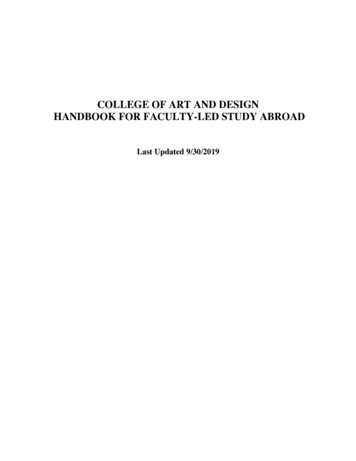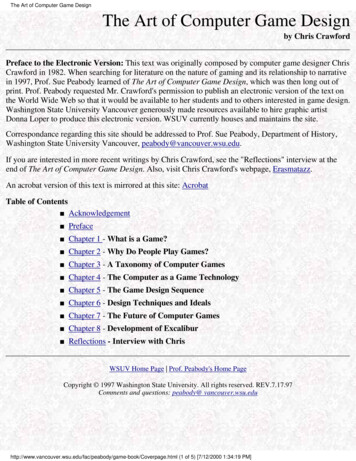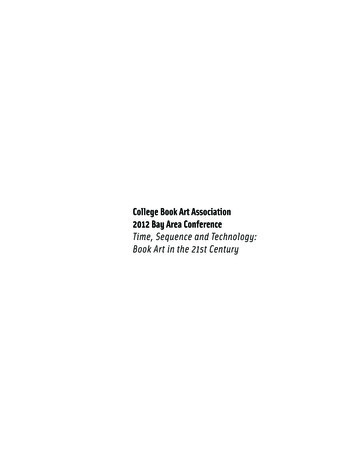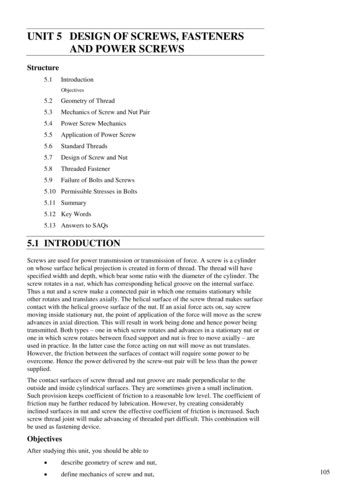
Transcription
COLLEGE OF ART AND DESIGNHANDBOOK FOR FACULTY-LED STUDY ABROADLast Updated 9/30/2019
Developing your ideaRIT has multiple frameworks in place for student education abroad, including studying at an RITglobal campus (Dubai, Dubrovnik, Pristina, Zagreb, Beijing, or Weihai), enrolling in an affiliateprogram (a program run by a partner institute, so that the student would still earn RIT credit), orparticipating in an RIT faculty-led program. Every RIT program has a pathway suggesting anoptimum semester for students to participate in study abroad, and students may complete morethan one study abroad experience. This guide specifically addresses developing faculty-led studyabroad programs. This involves a faculty member leading RIT students on programs thatincorporate travel outside of the United States. RIT offers different models for faculty-ledprograms, including:ModelSemester coursesSummer coursesTravel enhancementInternational researchKeep in mind Students need to be able to earnenough credits at the programdestination to make adequate progresstoward degree Faculty member has a workloadobligation to fulfill during thesemester—how will this be managed? Faculty member earns a summersalary With two faculty members, enrollmentmust be 16 or higher for each to earn afull salary; otherwise, they mustnegotiate to split the salary Students must pay additional RITtuition for summer credits Travel takes place over breaks or insummer, but is attached to a spring orfall course, with course meetingsduring the regular term Should be included in facultyworkload, not an overload Students pay for travel and programfees, but do not have to pay additionaltuition as long as they are not takingmore than 18 credits No faculty salary or travel costreimbursement; faculty travel costsmust be self-funded or built intostudent fees For experiences with an individualstudent or small group Follows the same application andvetting procedures as other models2
Consider which program model would work best for the experience. Read more about thedifferent possibilities here.Basic parameters: Planning for a new program should begin about a year and a half or more before theprogram would take place. Initial deadlines are typically in mid-fall for programs runningthe following fall, and mid spring for programs running the following spring or summer. In the College of Art and Design, faculty members leading study abroad courses must beunder contract and in full-time positions within our college: tenure-track, tenured,visiting, and all ranks of lecturer. You cannot have a conflict of interest with any third parties providing services (forexample, you cannot be compensated by a travel agent or service provider to directbusiness to them). College of Art and Design programs need a minimum of eight students (with theexception of the international research model). Faculty members must establish a compelling connection between course content and thedestination. RIT may prohibit travel to specific destinations based on risks to student and facultysafety. The College of Art and Design can request travel cost coverage for faculty from RITGlobal (with the exception of the international research model). Courses may be co-taught, though eight students per faculty member are needed tomaintain travel cost reimbursement from RIT Global or a full summer salary for eachfaculty member; with fewer than eight students per faculty member, travel costs for thesecond faculty member will be divided among the students and faculty members will splitthe summer salary. Courses must meet regular RIT curriculum requirements for credit hours (for example, athree-credit lecture course requires 45 contact hours plus time for work outside of class) Credit-bearing courses must be academic in nature. To participate, students must be full-time, matriculated RIT students in good academicand disciplinary standing. No one may audit a study abroad course. Planning and accounting procedures follow RIT and College of Art and Design travelguidelines.As you are considering developing a program, discuss your thoughts with stakeholders: yourprogram and department chair, advisors in your area, your department’s senior staff assistant andCollege of Art and Design financial liaisons to RIT Global, members of the College of Art andDesign committee on study abroad, and administrators at RIT Global. There are multiple issuesto consider. Primary among them: do you have the temperament, skills, and patience to plan,advertise, and lead a program where you are responsible for navigating a foreign country witheight or more students? These experiences can be extremely rewarding for all involved, but theyinvolve a great deal of mental and physical effort.3
1) Workload: How will this course be counted as part of your workload? For semester ortravel-enhancement courses, you will need to be able to include the course as part of yourusual workload. Do you have a backup plan if your program doesn’t fill? Have youincluded it as part of your plan of work? Give special thought to co-taught courses: if youhave ten students, can your department afford to have two professors devoted to tenstudents that term?2) Salary and travel costs: For summer courses, College of Art and Design faculty earn asalary based on the following calculation: 2000 base plus 300 (number of enrolledstudents) 100 (student credit hours generated). Travel enhancement or regular termcourses should be included within the normal workload. Overload pay is not typicallyavailable for leading elective study abroad courses. Travel costs (with a maximum formeals equivalent to 21 days of foreign per diem, currently 1638) can be reimbursed byRIT Global for any model except international research, as long as the program enrollseight students for each faculty member participating. If two faculty members lead fewerthan sixteen students, the second faculty member’s travel costs will be incorporated intothe students’ program fees. As this means higher costs and less predictability for students,faculty should take this into account when planning. See RIT Global’s requirements here.3) Curriculum: How will the course enhance curricular offerings? Are you offeringsomething new? Are you duplicating an existing program?4) Program model: Which program model best suits your idea? If you choose a faculty-ledmodel, what does your presence add that students could not otherwise do on their own?5) Audience: Who is the audience for the program? If it is specific to one major, are thereenough students to make the course feasible? Can the program fulfill any requirements?Can it be useful to multiple areas of study? Does it require prerequisites that might limitenrollment? Should the experience be limited to undergraduates, or could graduatestudents benefit from participating?6) Destination: Is the destination desirable for students? How many RIT programs involvethat destination? Too many in one region may mean too much competition. What specialskills or experience do you have to offer for students participating in your program? Doyou have local academic connections or cultural connections? Can you demonstrate aparticular skill or form of research/creative work while there? Are you familiar enoughwith the proposed destination to offer some expertise? If you need to cultivateconnections, consider applying for a FEAD grant for preliminary research a year inadvance, or apply to RIT Global for exploratory funding or a site ite-visitsHow will the program benefit from the destination? What does the destination offer forstudent learning that cannot be achieved at RIT? How will students experience the localculture, and how might it enhance their learning? Exposure to cultures outside of theirown can be eye-opening for students. You would ideally be a leader for students in thisregard. Remember that the culture in some areas may reveal different attitudes towardissues such as racial and ethnic diversity, sexual orientation, religious practice, disability,and gender expression. Can you prepare students to successfully navigate such issues inan ethically sound way? RIT Global has some resources on diversity abroad here.7) Visas: Will you need a visa? Will students need visas? If yes, what is the time frame forprocessing and what is the cost involved?4
8) Activities: What activities will be part of the experience at the destination? You mayinclude non-academic outings as part of the experience, but contact hours for a courseshould primarily consist of academically-oriented activities. Will you need to make groupreservations and arrange travel?9) Language: Do you speak the local language? Will students need to speak the language toparticipate? It is not required, but there are locations where it is not feasible to navigatewithout local language ability. If cultural immersion is a significant aspect of theexperience, language skills will help.10) Space and equipment: Where will the academic work take place? Will you needclassroom space, lab space, equipment, etc.? Will you need to borrow equipment fromthe cage, and is that possible? Do students need to bring laptops? Will they need highspeed internet?11) Partnership: If you are partnering with a foreign institution, RIT must establish at least aMemorandum of Understanding (MOU) with that institution.12) Room, board, and transport: Where will students stay, where will they eat, and howwill they get around? Is secure housing available at a reasonable price a convenientdistance from your daily activities? Will you stay in the same hotel or residence asstudents, or separately? Do lodgings have kitchen facilities? Can common requests forUS travelers (for example, dietary requests or non-smoking living spaces) beaccommodated? Consider day-to-day travel, but also travel to and from the airport on theUS side and the destination side. Will students travel as a group from the US? Will theybe able to get to their lodging from the airport alone, or do you need to arrange to meetthem? Is the destination walkable? Is public transport an option? Will you need a driveror drivers?13) Safety: How can safety be managed at the destination? Risk Management will vet alldestinations, and you will need to consider student safety and reasonable precautions.You should check with the US State Department, CDC, and World Health Organizationfor any warnings or recommendations for your destination.14) Accessibility: Is the course accessible to students with disabilities? Not all overseascourses can be accessible, but this is something to consider if at all possible, though manycountries do not have legislation protecting access to lodging, transport, or other publicservices for those with disabilities. It is possible for deaf or hard-of-hearing students torequest an accompanying interpreter through NTID, which then reimburses the travelexpenses of the interpreter.15) Dates: When will travel take place? For a travel enhancement course, do you need totravel before the course to gather material to work with, after the course to complementyour classroom experience or connect with a foreign partner, or during the course? Haveyou considered seasonal weather, term times at foreign institutions, seasonal closures,etc.? Note that summer travel is often easiest if it happens at the beginning or end of thesummer term, not in the middle. July travel may limit your audience if you have studentswho need to work, pursue a Co-op or internship, or take other summer courses.16) Communications: How will you handle communications while abroad? Will you haveaccess to the internet? How will you be reachable by phone?17) Finances: Will this experience be financially feasible for students? Students cannottypically take out loans for summer courses unless they are enrolled full-time; even then,their budget for the year is not increased.5
18) Student expectations: A course bearing academic credit is an academic experience: itmay be fun and exciting, but it also needs to have academic rigor appropriate to thesubject, site, and course level.19) Course proposals: Do you need to propose a new course or submit a new topic?Remember that a new course needs to go through the College curriculum committeeaccording to existing committee deadlines. If graduate students can participate, they needa course to enroll in.20) Assessment: How will students turn in assignments? When are grades due?Seek advice from College of Art and Design faculty with experience leading these programs,including:Roberley Bell, UAEMeredith Davenport, KosovoDenis Defibaugh, CubaJoyce Hertzson, ItalyAngela Kelly, IrelandDebbie Kingsbury, various destinations for College HonorsElizabeth Kronfield, China and ItalySarah Thompson, France and ItalyMary Golden, HondurasBrian Larson and MJ Blanchard, KosovoApplication to lead a study abroad programFaculty program application deadlines are typically a year in advance of when the studentswould need to enroll for such a program (for example, a faculty member wanting to lead aprogram in spring or summer 2019 would turn in an application early in the spring term of 2018).College of Art and Design faculty applicants need to turn in the Phase I application form, alongwith a CV, a personal statement, and a letter of support from their department chair. Thesematerials should go to the head of College of Art and Design Global (the college-level studyabroad committee). The committee will review the proposal and provide feedback. If theprogram is approved to move forward, the faculty member should turn in Phase II form, a budgetproposal, and a course outline (or outlines, if both undergraduates and graduates can go) to theCollege of Art and Design committee chair, college financial liaison, and RIT Global. Newcourse outlines and topics must go through the usual curricular procedures for approval.About Phase INote that the section to be signed by the dean will be handled by the college study abroadcommittee after reviewing your program.About Phase IIYou can find information about visas and health concerns via the US Department of State. Lookup your country’s recommendations here.Tips on preparing a budget Travel expenses for study abroad must conform to RIT and College of Art and Designtravel policies and accounting procedures. Read those guidelines carefully!6
Be realistic. You must look up specific dates of travel aligning with your program, andshould base costs on what you and students are likely to be able to purchase. If studentswould have to eat oatmeal three times a day to meet a 10/day food budget, don’t set thebudget at 10/day.Think through your program concept day by day to be sure you aren’t missing anyexpense categories.It is possible to bring an assistant, but assistant travel costs will not be covered by RITGlobal or College of Art and Design and must be calculated as part of the studentprogram fee. Assistants are not salaried though RIT Global or through the program fee.Make sure you remember travel to and from the airport at both ends in yourtransportation calculations.You will certainly need to include an amount for phone/internet access, and students willalso need to plan for this. Check with your cell phone provider for international plancosts, and remember that you may need to use quite a bit of data in an emergency.Students pay the program fee amount to RIT, and you are then in charge of spending thatmoney on program activities. You have to document these expenditures. To makeeveryone’s lives easier, include in this category only expenses that are required for theprogram, for which you will pay on the group’s behalf, and which do not vary fromperson to person. If everyone needs a travel pass and you will purchase them in bulk,include that; if you’re paying a driver for group excursions, include that. Meals takenseparately, groceries, snacks, taxi rides for individual sightseeing, souvenirs, etc. do NOTgo in this category.Because you must document expenses, minimize any instances where you would need todole out cash to individual students. If students will need to take taxis from the airport totheir lodging individually, have them budget for it in their spending money as opposed tocollecting it in a program fee and then having to reimburse students in cash.If group expenses are higher than expected once you’re abroad, you will need to do whatyou can to mitigate that. Once the program fee has been paid by the students, that’s theamount of money you have to work with for program expenses. You may need to makeadjustments while you are there to make sure you stay within the limit. On the otherhand, the exchange rate could go your way, and you could add in group excursions orgroup meals to get the most out of the program fee. Students are only issued refunds ofexcess fees if the excess is more than 250/student; otherwise any excess upon returnshould be used by the College of Art and Design for program development or directedtoward a class event.Build in a little room for price fluctuations or errors. Don’t pad too much, because youwant the cost to reflect students’ real costs and be as affordable as possible. However,you also don’t want to have to hike the cost once students have committed to theprogram. It is not acceptable to go over budget. If you go over budget, your School willneed to cover the deficit and you may forfeit your next round of professionaldevelopment funding.When you’re looking up travel costs and entry fees, check to see if students have areduced cost. If they qualify for reduced price tickets, check on what evidence must beprovided to receive the reduction and make sure they can provide it if asked. Since RITstudent ID cards do not have dates on them, some sites balk at accepting them.7
Sometimes a dated letter from the school or program chair can be an acceptablesupplement.An RIT-approved travel agent or coordinating institution may help you by bundlingexpenses. This may be more expensive than booking every event yourself, but will vastlycut down on paperwork and will make expenses more predictable. The more you can payfor in advance, in dollars, the easier the accounting process will be.Remember to include gratuities if you’re using tour guides or other local servicecoordinators. Check into local customs and amounts. If you will be tipping a tour guideor motor coach driver for the group, include the amount in the program fee. If studentswill need to pay their own tips, be sure to include this in the list of students’ out-ofpocket expenses.If you’re traveling with a partner or a child/children, remember that you must be able toaccount for your personal expenditures; your partner and/or dependents cannot haveexpenses covered by RIT. Similarly, people not associated with the course should not beincluded in any group expenses (for example: a graduate student wants to travel with aspouse who is not enrolled in the course—that spouse should not be present for programactivities, housed with RIT students, or included in group expenses).Look up historic exchange rates and go with the average over five years when planning.When processing receipts, you will use the exchange rate for the day of the expenditure,but when planning, you have to imagine that the rate might rise or fall from the time ofplanning to the time of travel.Initial student deposits are not refundable. If a student withdraws from a program withfewer than six weeks to go before departure, the student will be billed the balance of theprogram fee. Student funding guidelines are here. Consider how you could work withinthe budget if a student dropped out of the program after paying the initial deposit butbefore paying the balance of the program fee, and no alternates joined the program.Faculty members’ meal reimbursement maxes out at 1638 (21 days of international perdiem). If your program is
Every RIT program has a pathway suggesting an optimum semester for students to participate in study abroad, and students may complete more than one study abroad experience. This guide specifically addresses developing faculty-led study abroad programs. This involves a faculty memb











